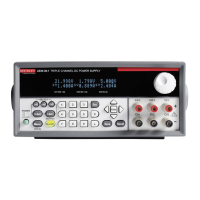Specifications
Table 4: Combin
ed channel characteristics
Characteristic Description
Combined Channel
Characteristics, nominal
The unit can be configured to provide functionality on Channel 1 and Channel 2 together.
Series Combinations, nominal Deliver up to 60 V when CH1 and CH2 are wired in series. Voltage Readback is the combined
voltage. Se
ttings changes are to the combined voltage. Current Readback is for Channel 1
only. If the currents in the two c hannels are significantly different there is no indication of
CC/CV status for Channel 2.
Available Series Configurations,
nominal
Channels 1 and 2 are connected in series. E ither channel 1 or channel 2 may be the most
positive s
ource.
Series Co
mbination Voltage
Accuracy, typical
±(0.10% o
f the setting + 50 mV) at 25 °C ±5 °C
Series Combination Current
Accuracy, typical
±(0.1% + 5 mA) at 25 °C ±5 °C for Channel 1's current.
The current is only m easured for C hannel 1. The error is the same as for the Current
Measure
ment Accuracy.
Paralle
l Combination, nominal
Deliver
s up to 3 A when CH1 and CH2 are wired in parallel. The meter reads back the
combined current.
Available Parallel C on figurations,
nominal
CH1 and CH2 are connected in parallel (+ to + and – to –)
Parallel Combination Voltage
Accur
acy (typical)
±(0.05% of setting + 10 m V) at 25 °C ±5 °C
Para
llel C om b ination Current
Accuracy, typical
±(0.
2% +10 mA) at 25 °C ±5 °C
Table 5: 2230-30-1 and 2230J-30-1 unit characteristics
Characteristic Description
Unit Characteristics, nominal Characteristics and specifications of features unique to this product, but unrelated to a
particular channel.
2230-30-1
Line Selection
Switch
Voltage Frequency Fuse Rating Max VA
110V
110/115/120 50/60 Hz
6.3A TH 250V 450
220V
220/230/240 50/60 Hz
3.15A TH 250V 450
2230J-30-1
Line Selection
Switch
Voltage Frequency Fuse Rating Max VA
110V 100
50/60 Hz
6.3A TH 250V 450
Unit SpecificMains
Requirements
220V 200
50/60 Hz
3.15A TH 250V 450
Maximum Input V, Typical 450 VA
Series 2200 Multichannel Programmable DC Power Supplies Technical Reference 7

